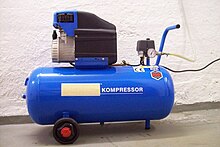Piston compressor
A piston compressor is a tool from the group of compressors . When gases are compressed, these increase in density, which leads to more heat and pressure in the piston compressor tank. Piston compressors are mainly used in the automotive sector and in combination with compressed air tools. Piston compressors work with cylinders and pistons. Despite this mode of operation, there are numerous piston compressors that work oil-free, especially in the cheaper range.
functionality
Basic principle
The piston in the cylinder compresses the gas in a closed space. It is then released in a certain direction through a compressed air hose or various couplings, in order, for example, to operate compressed air tools.
In a reciprocating compressor, the piston moves up and down in the cylinder. When the pump chamber is enlarged, air is sucked in through an air filter . Then the inlet valve closes and the piston reduces the size of the pump chamber, compressing the air and releasing it through the outlet valve.
For rotary lobe compressors, see Roots blower and rotary lobe pump .
drive
Most reciprocating compressors for home and workshop use are electrically powered. The output of these devices is usually in the range of 1–2 kilowatts . Due to the great popularity of these devices in the home and craftsman segment, most hardware stores now have a large number of electrically operated piston compressors in their range. These are also popular in smaller workshops. However, there are also piston compressors that run on gasoline. These are normally used in industry, since in smaller workshops or rooms, both the noise and exhaust emissions from internal combustion engines are significantly higher.
Oil-lubricated / oil-free reciprocating compressors
A general distinction is made between oil-lubricated and oil-free piston compressors. The latter in particular are already often used in the home and in smaller workshops, but with a rather low working pressure and manageable suction and discharge volumes. This means that they can only be used to a limited extent for work in the industrial sector. Oil-lubricated compressors are increasingly found there, but they produce compressed air containing oil when they are compressed. This is unusable in numerous branches of industry and is cleaned with the help of oil separators . In contrast to oil-free compressors, the oil-lubricated counterparts often have more than one cylinder. This means that a higher maximum pressure can be generated and, moreover, the suction capacity increases. This means that it can be used with compressed air tools that require more air, such as a pneumatic impact wrench.
Parameters
Important parameters of a piston compressor are the maximum pressure, the tank volume and the intake and discharge volume. With conventional piston compressors for workshop and home use, the maximum pressure is in the range of 5–20 bar. Many compressed air tools have minimum requirements in the areas of pressure and tank capacity - if the compressor is too weak, they cannot be operated sufficiently effectively. Not every piston compressor has a boiler, but this is very useful, for example, to carry out longer work without the compressor running. It can be viewed as a compressed air reservoir. The suction and discharge volume is specified in liters per minute and is important for operation with various compressed air tools with high air requirements.
Areas of application
Piston compressors are mainly used in the following areas:
- Airbrush and painting
- Pneumatic tools in workshops (impact wrenches, nailers, staplers, pistols)
- Home use: inflating air mattresses, balls, tires
- Household refrigerators (compressor refrigerators)
Individual evidence
- ↑ FOCUS Online: What are compressors and turbochargers? In: FOCUS Online . ( focus.de [accessed on July 23, 2018]).
- ↑ Compressor Oil in the Air - Cause, Background & Effects. Retrieved on July 30, 2018 (German).
- ↑ Super User: Compressed air - generation of oil-free compressed air. Retrieved July 30, 2018 .
- ↑ Compressors: function types & manufacturers. Retrieved July 23, 2018 .
